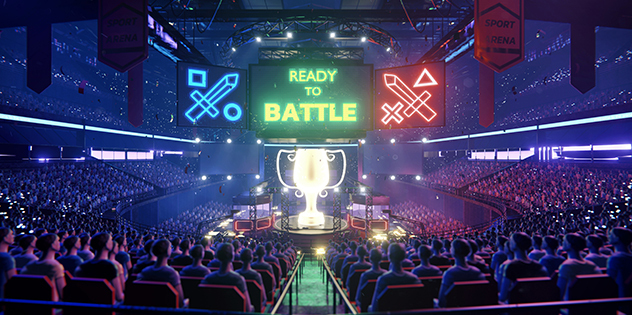COVID-19 put live sporting events — both digital and traditional varieties — on hold.
The unprecedented event cancellations of 2020 sent venues large and small scrambling for innovative ways to recoup their losses. And while it will take time before we see sold-out crowds filling venues again, it’s never too early to start strategizing for your post-pandemic revenue streams. Enter esports, the professional gaming spectacle that may just be the missing piece of the puzzle for sports facility owners in the future.
Before the pandemic, the niche world of professional gaming was selling out tickets in arenas big and small, from converted high school wrestling gyms to standing-room-only packed professional sports stadiums around the world.
Now, with esports revenue projections slated to surpass the $1 billion milestone this year — and reach $1.8 billion next year — the hottest new digital entertainment trend looks like it’s here to stay. Considering that the video game industry already tops the revenue of the music and movie industries, esports seems to be a bandwagon worth jumping on.
What is esports?
In a nutshell, esports are highly competitive multiplayer video games played live in front of audiences.
In many ways, they’re similar to the traditional sports we know and love — albeit somewhat less sweaty. Esports encompasses several different video games (notably games like Fortnite and League of Legends), each with its own set of rules, dedicated leagues, enormous prize winnings and passionate fanbases. Gaming competitions are every bit as thrilling to its audiences, and, unlike traditional sports, every season can be esports season.
While competitive video games may not be considered “mainstream” yet, the numbers suggest otherwise. The video game industry reached $100 billion in revenue in 2019, and its esports vertical boasts a fanbase rapidly approaching 500 million people worldwide.
It's time to reimagine your scoreboard
Schools now have access to stadium-worthy, large-scale displays. Learn how they transform campuses. Download Now
The colossal growth of esports is spurred by more than massive one-off tournaments among a growing number of high schools (think varsity League of Legends), colleges and professional gamers. Esports are starting to be considered a regular sport with leagues and consistent matches.
Esports athletes are offered full-ride scholarships to play at universities, some of which are even equipping themselves with training facilities and stadiums to accommodate. Then there are the leagues at the professional level who play for money — sometimes lots of it — who need sponsors and “home” stadiums just like your favorite baseball team. Even the International Olympic Committee is considering adding esports to the list of Olympic sports.
Despite the COVID-19 pandemic — and perhaps because of it — esports continues to gain online viewership in streaming audiences on Twitch and YouTube. Since the beginning of the government-mandated closures, esports fans have been watching tournaments from home without missing a beat.
“With esports, tournaments continue to get played because they don’t need a venue,” says Gary Kayye of rAVe Publications, the audiovisual industry’s leading consulting and marketing agency.
While esports tournaments don’t technically need a venue to take place, they won’t be watched online forever. Devoted fans are ready to flock to converted arenas for a live taste of the action.
Multipurpose venues’ need for screens
According to Kayye, converted multipurpose stadiums will host the majority of these gaming competitions once more pandemic restrictions begin to lift: “In the case of esports,” he says, “most arenas are converting or using the same plan that they use to convert an arena into a concert venue.”
But the experience of esports is different than your typical sporting event or concert: “Even though it’s set up like a concert, unlike a concert, you’re not there to hear; you’re there to watch. The visuals have to be significantly better,” Kayye explains.
While dedicated esports arenas have begun cropping up in Asia and some parts of the U.S., Kayye says the use of existing facilities — repurposed and equipped to accommodate the video gaming spectacles — will prevail in the near future.
“Prior to COVID-19, you would have potentially seen a lot of universities investing in esports, and now the investment’s going to come from the gaming side,” Kayye says. “I think the driver is going to be getting the gaming companies to finance it. In that case, a lot of them will be repurposed facilities, from small gyms people use for gymnastics, wrestling — sports like that — that are used for esports as well.”
Samsung is your ultimate esports display partner
The logistics to bring these events together are massive, but a key piece is selecting the right display solution.
“In this case, you’re going to have to engage an audience member who’s 800 feet away,” Kayye explains. “You’re going to have to have many more displays and much more engaging content on those displays.”
In other words, one center-hung display, such as the one at a professional basketball game, isn’t going to cut it. “I don’t think you can count on one giant display in one place,” says Kayye. “I think you’re gonna have to distribute them all over, which is very different than anything else you use a venue like that for.”
With industry-leading brightness, processing speed and custom installation capabilities, Samsung displays are the perfect match for the visual challenge that esports present.
To stay competitive, every esports player relies on best-in-class tech, including their display. Discover Samsung’s full lineup of innovative gaming monitors — designed for professionals and hobbyists alike. And as you reimagine your esports stadium displays, consider redesigning your scoreboard for maximum impact, as outlined in this free comprehensive guide.








